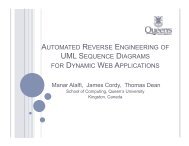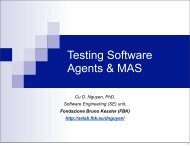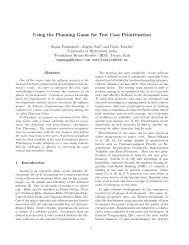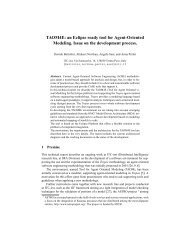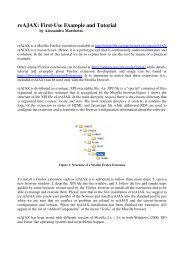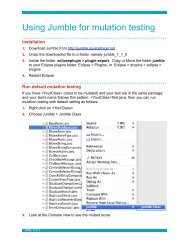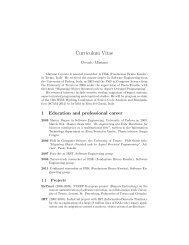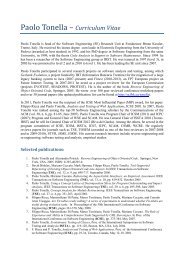PDF version of the paper. - FBK | SE
PDF version of the paper. - FBK | SE
PDF version of the paper. - FBK | SE
Create successful ePaper yourself
Turn your PDF publications into a flip-book with our unique Google optimized e-Paper software.
Table 2: Comprehension tasksCarRace T1 In order to refuel <strong>the</strong> car has to enter <strong>the</strong> box. The box areais delimited by a red rectangle. What is <strong>the</strong> width <strong>of</strong> <strong>the</strong> boxentrance (in pixel)?T2 When <strong>the</strong> car crosses <strong>the</strong> start line, <strong>the</strong> number <strong>of</strong> laps is increased.Identify <strong>the</strong> section <strong>of</strong> code that increases <strong>the</strong> number<strong>of</strong> laps <strong>the</strong> car has traveled (report <strong>the</strong> class name/s andline number/s with respect to <strong>the</strong> printed <strong>paper</strong> sheets).Chat T1 Messages going from <strong>the</strong> client to <strong>the</strong> server use an integeras header to distinguish <strong>the</strong> type <strong>of</strong> <strong>the</strong> message. What is <strong>the</strong>value <strong>of</strong> <strong>the</strong> header for an outgoing public message sent by<strong>the</strong> client?T2 When a new user join, <strong>the</strong> list <strong>of</strong> <strong>the</strong> displayed “Online users”is updated. Identify <strong>the</strong> section <strong>of</strong> code that updates <strong>the</strong> list <strong>of</strong>users when a new user joins (report <strong>the</strong> class name/s and linenumber/s with respect to <strong>the</strong> printed <strong>paper</strong> sheets).Table 3: Change tasksCarRace T3 The car can run only on <strong>the</strong> track and obstacles have to beavoided, if a wall is encountered <strong>the</strong> car stops. Modify <strong>the</strong>application such that <strong>the</strong> car can take a shortcut through <strong>the</strong>central island.T4 The fuel constantly decreases. Modify <strong>the</strong> application suchthat <strong>the</strong> fuel never decreases.Chat T3 Messages are sent to a give room, if <strong>the</strong> user is registered in<strong>the</strong> room and if <strong>the</strong> message is typed in <strong>the</strong> correspondingtab. Modify <strong>the</strong> application such that all <strong>the</strong> messages from<strong>the</strong> user go to “Room 1” without <strong>the</strong> user entering <strong>the</strong> room.T4 Messages are sent and displayed with <strong>the</strong> timestamp thatmarks when <strong>the</strong>y have been sent. Modify <strong>the</strong> application suchthat <strong>the</strong> user sends messages with timestamp equals to 3,00PM.subjects sent us back, and evaluated <strong>the</strong> change as successful if testcases passed. A test case was defined for each change task, usinga black-box strategy. They consists in sending an appropriate sequence<strong>of</strong> graphic events to delivered client, and verifying whe<strong>the</strong>r<strong>the</strong> required changes have been performed correctly using a specialtesting server.The main factor <strong>of</strong> <strong>the</strong> experiment—that acts as an independentvariable—is <strong>the</strong> obfuscation (identifier renaming). Such a factorcan have two treatment levels, i.e., subjects can perform <strong>the</strong> comprehensionand change on obfuscated, decompiled source code oron clear, decompiled source code (control groups used for comparisonpurposes).The results can be affected by o<strong>the</strong>r factors, such as:• <strong>the</strong> System used in <strong>the</strong> comprehension/maintenance task: asdetailed in Section 3.2, to use a balanced design we needtwo objects. Although <strong>the</strong>y are comparable in complexity,subjects can perform differently on different systems;• <strong>the</strong> subjects’ Ability, we have assessed considering bachelorgrade and previous exams grades. According to <strong>the</strong> assessmentmade, we have classified subjects in High and Lowability subjects.• <strong>the</strong> Lab: since <strong>the</strong> experiment requires two laboratories, alearning effect is possible from labs, and it should be analyzed.3.2 Experiment designWe adopted a balanced experiment design intended to fit two Labsessions (2-hours each). Subjects were split into four groups, eachone working in Lab 1 on a system with a treatment and working inLab 2 on <strong>the</strong> o<strong>the</strong>r system with a different treatment (see Table 4).Table 4: Experiment design(O) = Obfuscated, (C) = Clear.Group A Group B Group C Group DLab 1 CarRace (O) CarRace (C) Chat (C) Chat (O)Lab 2 Chat (C) Chat (O) CarRace (O) CarRace (C)The design ensures that each subject worked on different Systemsin <strong>the</strong> two Labs, receiving each time a different treatment.Also, <strong>the</strong> design permits us to consider different combinations <strong>of</strong>System and treatment in different order across Labs. More important,<strong>the</strong> chosen design permits <strong>the</strong> use <strong>of</strong> statistical tests (Two-Wayand Three-Way ANOVA[6]) for studying <strong>the</strong> effect <strong>of</strong> multiple factors.Subjects were split into four groups making sure that high andlow Ability subjects were equally distributed across groups.3.3 Experiment material and procedureThis section details <strong>the</strong> procedure we followed to perform <strong>the</strong>study. Before <strong>the</strong> experiment, subjects were properly trained withlectures on obfuscation techniques, and with exercises having <strong>the</strong>purpose <strong>of</strong> performing comprehension tasks on <strong>the</strong> (non-obfuscated)source code <strong>of</strong> a simple vending machine system. Right before <strong>the</strong>experiment, we provided to subject a detailed explanation <strong>of</strong> <strong>the</strong>tasks to be performed during <strong>the</strong> lab, without however explicitly<strong>the</strong> study hypo<strong>the</strong>ses, to avoid a possible bias.To perform <strong>the</strong> experiment, subjects used a personal computerwith <strong>the</strong> Eclipse development environment—which <strong>the</strong>y are familiarwith—, including notably syntax highlighting and debugger,and <strong>the</strong> Java API documentation available. We distributed to subjects<strong>the</strong> following material:• a short textual documentation <strong>of</strong> <strong>the</strong> system (CarRace or Chat)<strong>the</strong>y had to attack, comprising installation instructions;• a jar archive containing <strong>the</strong> server <strong>of</strong> <strong>the</strong> application. Asmentioned above, both CarRace and Chat are client-serverapplications; to avoid during <strong>the</strong> experimentation problemsdue to reduced bandwidth or limited Internet access (<strong>of</strong>tendue to University laboratory restrictions) we let <strong>the</strong> subjectsrunning <strong>the</strong> server locally, without providing <strong>the</strong> source codeand checking <strong>the</strong>y do not decompile it;• <strong>the</strong> decompiled client source code, ei<strong>the</strong>r clear or obfuscateddepending on <strong>the</strong> group <strong>the</strong> subject belonged to (Table 4);• printouts <strong>of</strong> <strong>the</strong> slides explaining <strong>the</strong> experiment procedure,that we presented just before distributing <strong>the</strong> material.The experiment was carried out according to <strong>the</strong> following procedure.Subjects had to:1. read <strong>the</strong> application description;2. import <strong>the</strong> client source code in Eclipse;3. run <strong>the</strong> application to familiarize with it;4. for each <strong>of</strong> <strong>the</strong> four tasks to be performed:(a) ask <strong>the</strong> teacher a <strong>paper</strong> sheet describing <strong>the</strong> task to beperformed;(b) mark <strong>the</strong> start time;(c) read <strong>the</strong> task and perform it;(d) write <strong>the</strong> answer (for comprehension tasks);(e) mark <strong>the</strong> stop time and return <strong>the</strong> <strong>paper</strong> sheet;



